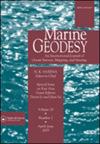Comparing the Performance of Turbulent Kinetic Energy and K-Profile Parameterization Vertical Parameterization Schemes over the Tropical Indian Ocean
IF 1.4
4区 地球科学
Q2 GEOCHEMISTRY & GEOPHYSICS
引用次数: 7
Abstract
Abstract The performance of vertical parameterization schemes, namely, turbulent kinetic energy (TKE) and K-profile parameterization (KPP), is evaluated over the domain [30E-120E; 20S-30N] in the Indian Ocean using the Nucleus for European Modeling of the Ocean (NEMO) regional model. The surface and sub-surface hydrography and mixed layer depth (MLD) of the simulations using TKE and KPP schemes have been compared. The KPP scheme produces higher bias (∼0.5 °C) of sea surface temperature (SST) in monsoon and post-monsoon seasons, which reduces on using the TKE scheme. The maximum surface salinity difference (0.45 psu) between TKE and KPP simulations is obtained over the head Bay of Bengal (BoB) in the post-monsoon months. The KPP scheme also overestimates MLD of the region. Barring highly convective regions as well as regions marked with very low and rapidly changing salinity, the TKE scheme performs better than KPP scheme in simulating the hydrography and MLD of the region. The differences between TKE and KPP simulations in the vertical stability and mixing are studied using buoyancy frequency, vertical shear of horizontal currents and energy required for mixing as quantifiers. The mixed layer heat budget analysis explains seasonal variability of SST and differences in vertical mixing parameterizations.热带印度洋湍流动能和k线参数化垂直参数化方案的性能比较
摘要使用欧洲海洋建模核(NEMO)区域模型,在印度洋[30E-120E;20S-30N]域上评估了垂直参数化方案,即湍流动能(TKE)和K剖面参数化(KPP)的性能。对TKE和KPP方案模拟的地表和亚表层水文和混合层深度(MLD)进行了比较。KPP方案产生更高的偏置(~0.5 °C)的海面温度(SST),这在使用TKE方案时会降低。TKE和KPP模拟之间的最大表面盐度差(0.45 psu)是在后季风月份孟加拉湾(BoB)上空获得的。KPP方案也高估了该地区的MLD。除了高对流区域以及盐度极低且变化迅速的区域外,TKE方案在模拟该区域的水文和MLD方面比KPP方案表现更好。使用浮力频率、水平流的垂直剪切和混合所需的能量作为量化指标,研究了TKE和KPP模拟在垂直稳定性和混合方面的差异。混合层热预算分析解释了SST的季节变化和垂直混合参数化的差异。
本文章由计算机程序翻译,如有差异,请以英文原文为准。
求助全文
约1分钟内获得全文
求助全文
来源期刊

Marine Geodesy
地学-地球化学与地球物理
CiteScore
4.10
自引率
6.20%
发文量
27
审稿时长
>12 weeks
期刊介绍:
The aim of Marine Geodesy is to stimulate progress in ocean surveys, mapping, and remote sensing by promoting problem-oriented research in the marine and coastal environment.
The journal will consider articles on the following topics:
topography and mapping;
satellite altimetry;
bathymetry;
positioning;
precise navigation;
boundary demarcation and determination;
tsunamis;
plate/tectonics;
geoid determination;
hydrographic and oceanographic observations;
acoustics and space instrumentation;
ground truth;
system calibration and validation;
geographic information systems.
 求助内容:
求助内容: 应助结果提醒方式:
应助结果提醒方式:


